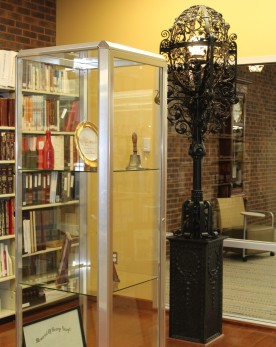This is a reprint of a “From the Local History Room” column that first appeared in May 2015, before the launch of this weblog.
The pioneer doctors of Pekin
By Jared Olar
Local History Specialist
When local historian and journalist Ben C. Allensworth in 1905 undertook to update and augment Charles C. Chapman’s 1879 “History of Tazewell County,” he no doubt saw that one aspect of local history that Chapman had overlooked was the origin and development of the medical profession in Tazewell County. Allensworth therefore asked Dr. W. E. Schenck to write a special chapter providing an account of the “Pioneers in the Medical Profession,” found on pages 880-882 of Allensworth’s history.
Dr. Schenck began his account with a general description of “the pioneer doctor,” who
“was not educated in his profession as the modern physician has been. He was scholastic, often polished, but many things are now in common use that were unknown in his day. He had no knowledge of chloroform. The elegant pharmaceutical products which we now dispense were not to be had in his day. The X-ray had not been dreamed of, and modern surgery, which has astonished the world by its boldness, and gratified suffering humanity by its success, would have been considered cruel rashness a generation ago. With his ponderous saddle-bags he went from his humble domicile on hi mission of humanity and never refused to respond to a call, no matter what the prospects for remuneration. He was often compelled to make long rides in all kinds of weather and all conditions of roads; was often detained for many hours where his only compensation was the gratitude of a suffering patient, and not always even that. His powers of observation were very acute. He usually readily discovered the nature of the difficulty and promptly gave a suitable remedy; though it was not always pleasant to take. He lived, and loved to live, for his work, and the good he did lives after him. He was, by all odds, the most useful man in the community, the most universally beloved and most missed when he died.”
After sketching the life of a pioneer doctor in general terms, Schenck provided a list with brief personal descriptions of Tazewell County’s early doctors and physicians, grouped according to the communities in which they lived and worked. Schenck’s list covers Pekin, Washington, Tremont, Groveland, Delavan, Mackinaw and Minier. Following is how Schenck summarized the story of Pekin’s first doctors:
“Dr. John Warner was the first physician of whom we can find any account in Tazewell County. He was located in Pekin at the time of the Deep Snow — the last days of December, 1830. Nothing more can be learned.
“Dr. S. Pillsbury came to Pekin in 1831 and was prominent in the profession and in society for many years. He died here and is still favorably remembered by the oldest citizens. In 1834 one Dr. Perry and his wife died of cholera in Pekin. Drs. Pillsbury and Griffith were the only doctors left in Pekin after the death of Dr. Perry.
“Dr. William S. Maus came to Mackinaw in 1831 and to Pekin in 1838. He served one term in the legislature in 1838. He died in Pekin in 1870.
“Dr. Joseph S. Maus came to Mackinaw in 1838 and to Pekin in 1853. He died in Pekin in 1872. The Doctors Maus were highly educated and successful physicians. They had the confidence and esteem of the community for many years and their memory is still fondly cherished by all who knew them.
“Dr. Samuel Wagenseller was one of the most noted characters that the profession ever had in this county. He came to Pekin in 1849. He read with Dr. Fitch and began practice in 1855. He was for many years at the head of the profession in this county, and no man ever succeeded in getting such a hold on the people as he. He was killed by accident October 7, 1877.
“Dr. R. C. Charlton was born in Ireland. He was a graduate at the ‘School of Medicine, Apothecaries’ Hall,’ Dublin, December 5, 1837. He practiced many years in Pekin and died of pneumonia, the result of exposure in his professional duties, at the age of 73.”

